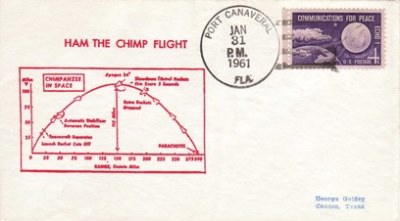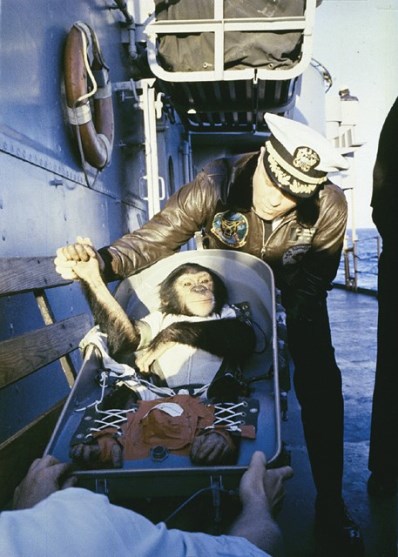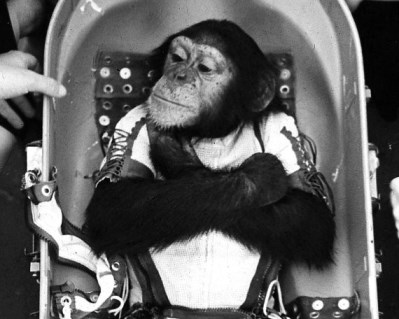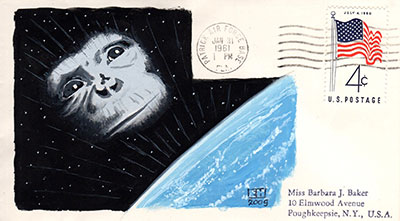Astrochimp Ham Boards His Spacecraft on Mercury Redstone 2, photo credit courtesy of NASA.Space chimp Ham's name is an acronym for Holloman Aerospace Medical Center, and he is one of two chimps that are suited the morning of the flight of Mercury Redstone-2. A second chimp, a female, is also suited up, but Ham's spunkiness, attentiveness, and energy make him the selected chimp for the flight. The test flight of astrochimp Ham in Mercury Redstone-2 is a full dress rehearsal for an anticipated manned ballistic flight to be made in a few weeks by Project Mercury astronaut Alan Shepard.
Space Cover #467: Astrochimp Ham's Space Flight Delight!

Early Joe Fitzpatrick and Carl Swanson Spacecraft Cover for the launch of space chimp Ham is pictured the morning of the launch date, Patrick Air Force Base, Florida.
Ham is launched into a picture perfect blue sky over Cape Canaveral, Florida, on his suborbital flight in Mercury Redstone-2, five minutes before noon on January 31, 1961. He splashes down 16.5 minutes later, 363 miles downrange, near Grand Bahama Island in the Atlantic Ocean.
His splashdown location is 60 miles from the nearest recovery ship, U. S. Navy destroyer USS Ellison, DD-864. Two MAG-26 helicopters from the primary recovery ship, USS Donner, LSD-20, fly to space chimp Ham's splashdown position and successfully make his recovery.

Classic George Goldey space cover for the recovery of astrochimp Ham after his space flight.
Space chimpanzee Ham's flight profile from launch to splashdown is pictured on this George Goldey splashdown cover for his suborbital flight down the Atlantic Missile Range and recovery in the Atlantic Ocean. No primary recovery ship covers for the USS Donner crew or for the Marine recovery helicopter crews of MAG-26 are known for the recovery of the Mercury Redstone-2 spacecraft with space chimp Ham.

Ham is welcomed aboard USS Donner by the ship's commanding officer, photo credit NASA.
Upon recovery of Ham's space capsule, the recovery team finds two holes in the titanium bulkhead of the spacecraft caused by impact of the splashdown of the capsule, and they also find an open inlet valve. The leaks and intrusion of seawater start to sink the space capsule, but one of the MAG-26 recovery helos lifts the leaky spacecraft with Ham and flies him to safety and the deck of the primary recovery ship, USS Donner.
Upon landing on the ship after his flight, Ham is found to be in good condition and readily accepts the award of an apple and half an orange from his trainer. The space chimp has performed superbly in his flight into space.
More importantly, Ham's successful flight proves that an astronaut also can survive a Project Mercury suborbital flight. Will an astronaut perform as well?
— Steve Durst, SU 4379















